By Sidra Shaukat
May 28th, 2025, marks the 27th anniversary of the nuclear tests conducted in the rugged hills of Chagai, Balochistan by Pakistan.

The day is remembered as Youm-e-Takbeer, symbolizing national pride and resilience. This milestone is often viewed through the lens of regional security and deterrence, however, despite its military and strategic significance, this moment also marked Pakistan’s journey towards a socio-economic transformation.
The popular narrative has only focused on Pakistan’s ability to establish Deterrence, but what remains underappreciated is how Pakistan’s nuclear program has evolved to contribute significantly to the human security of Pakistan. In essence, Pakistan not only achieved strategic stability in South Asia through its nuclear program but also reached the milestone of utilizing nuclear science to advance the socio-economic well-being of its people.
The nuclearization of South Asia began with India’s nuclear tests on May 11 and 13, 1998, disturbing the fragile strategic equilibrium in the region. These tests carried aggressive strategic undertones and an attempt by India for a stark assertion of regional dominance. It was a critical regional strategic development that could not go unanswered by Pakistan.
Pakistan and India have fought multiple wars and skirmishes since 1947, and with the bitter memory of the 1971 war still fresh, Pakistan found itself at a strategic crossroads. Inaction in the face of Indian Nuclear tests would have encouraged Indian hegemony, eroded Pakistan’s deterrence posture, and potentially destabilized the entire region.
Despite immense international pressure, the leadership in Islamabad chose national interest over global appeasement. On May 28, 1998, Pakistan conducted a series of nuclear tests in the Chagai Hills of Balochistan, thereby restoring the balance of power and signaling a clear message that strategic stability in South Asia was now established. These tests were never an aggressive move.
Pakistan’s nuclear doctrine has always emphasized Credible Minimum Deterrence, a strategy aimed at maintaining stability without fueling an arms race. Islamabad’s responsible approach to nuclear command and control is also reflected in its National Command Authority and robust safety mechanisms which have further highlighted its commitment to restraint and responsibility.
Nonetheless, over time, the global understanding of security has broadened and traditional military definitions have given way to a more human-centric security paradigm. In this broader vision, threats are not only tanks and missiles, but hunger, disease, and energy scarcity. By understanding these evolved human-centric security threats, Pakistan has also aligned its resources accordingly.
The Pakistan Atomic Energy Commission (PAEC) recognized the untapped potential of nuclear science and started its efforts to apply nuclear technology for peaceful purposes across multiple sectors, making nuclear technology an instrument not only of deterrence but also of development.
The PAEC established four agriculture and biotechnology research institutes dedicated to improving crop quality, pest control, animal health, and sustainable farming practices. These centers have played a crucial role in addressing Pakistan’s food security challenges by developing high-yield, drought-resistant seed varieties and improving soil and water management techniques.
In a country where agriculture remains the backbone of the economy and a primary source of employment, this application of nuclear technology directly contributes to food security and rural prosperity. It also plays a role in stabilizing prices, reducing reliance on imports, and increasing exports through improved agricultural practices.
Pakistan also faces chronic energy shortages that have long stifled growth, primarily amid a growing population and industrial sector. Nuclear power offers a clean, efficient, and sustainable solution. According to the Energy Security Plan of Pakistan, the goal is to produce 8,800 MWe of nuclear energy by 2030, helping reduce dependency on fossil fuels and bridging the demand-supply gap. In 2014, PAEC announced plans to construct five new 1100 MWe nuclear power plants, significantly scaling up existing capacity.
Furthermore, international confidence in Pakistan’s nuclear energy program has grown, as evidenced by the International Atomic Energy Agency (IAEA) launching project PAK2007 in 2018. This four-year collaboration aimed to enhance regulatory, operational, and safety capabilities and has positioned Pakistan as a responsible nuclear power.
One of the most impactful applications of nuclear technology on a personal level has been in healthcare, particularly in the diagnosis and treatment of cancer. The PAEC has established 19 cancer treatment hospitals nationwide, offering services to nearly one million patients annually. For many, these hospitals are the only hope, offering affordable and, in many cases, free treatment to the underprivileged. From early detection technologies to radiotherapy and nuclear imaging, these centers have revolutionized cancer care in Pakistan. Amid higher numbers of cancer patients and the lack of sufficient healthcare infrastructure, the PAEC’s contributions are nothing short of life-saving.
Pakistan’s focus on peaceful nuclear applications aligns closely with the United Nations Sustainable Development Goals (SDGs), notably SDG 2 (Zero Hunger), SDG 3 (Good Health and Well-Being), SDG 7 (Affordable and Clean Energy), and SDG 9 (Industry, Innovation, and Infrastructure). Pakistan has taken meaningful steps toward fulfilling its international obligations and improving the quality of life for its citizens by adjusting nuclear science to domestic development needs.
In the end, it is important to remember that Pakistan was never eager to go nuclear. For years, it advocated for a nuclear-weapons-free South Asia and tried to keep the region from sliding into an arms race. However, faced with India’s persistent strategic ambitions, Pakistan was left with no choice but to develop its own deterrent capability. Unlike others, Pakistan has not used its nuclear status as a geopolitical bargaining chip. It has neither sought regional dominance nor engaged in dangerous brinkmanship. Instead, it has maintained a policy of restraint and responsibility, investing in safety protocols and non-proliferation standards that meet international expectations.
As Pakistan observes Youm-e-Takbeer this year, the conversation must evolve beyond nuclear tests and warheads. The true measure of Pakistan’s nuclear journey lies not only in military might but in its contributions to human security and sustainable development.
Pakistan has demonstrated that nuclear science can be an agent of progress, not just power, by making targeted investments in agriculture, energy, and healthcare. It is imperative, now more than ever, that this dual-purpose legacy should be sustained and continued support for scientific research and international cooperation should also be ensured as the atom remains a tool of hope.
Author: Sidra Shaukat – MPhil in International Relations from the National Defence University. Research Officer at the Strategic Vision Institute, Pakistan.
(The views expressed in this article belong only to the author and do not necessarily reflect the editorial policy or views of World Geostrategic Insights).







